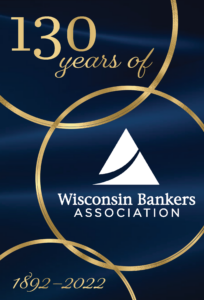Posts
Thank you for your continued support
 By Hannah Flanders
By Hannah Flanders
2022 marks the 130-year anniversary of the Wisconsin Bankers Association (WBA). In celebration of another year assisting Wisconsin banks to better serve their communities, WBA looks back at its humble beginnings, the challenges and growth faced over the last 130 years, and each legacy WBA brings forth into the future.
The Dawn of a New Era
On March 24, 1892, 150 curious bankers met at the Plankinton House in Milwaukee for the first time in nearly 30 years. The meeting’s agenda — creating an organized group of bankers to promote the general welfare and usefulness of the banks in the state. Following many years of general distrust in the banking and money systems, Wisconsin joined 20 other states in establishing a bankers association.
A handful of banks from around the state paid $5 each to join the new organization. The first members of the newly formed Wisconsin Bankers Association wasted no time passing two resolutions urging action on current banking legislation. As is today, advocacy has always lied at the heart of WBA’s mission in supporting the banking industry.
Led by WBA’s first president, N.B. Van Slyke of First National Bank of Madison, the Association’s guidelines, goals, formal Constitution, and bylaws were created and ratified. And so began the next 130 years of overcoming obstacles and meeting new challenges in an ever-evolving industry, all with the goal of serving the consumers of Wisconsin.
Laying the Foundation
With nearly 30 years under its belt and an overall reassurance in the banking system, WBA set its roots down in Milwaukee in 1921. WBA was quickly evolving into the association it is today — from life insurance plans to encouraging bankers to involve themselves with the financial education of their community — several aspects of WBA’s early history developed into subsidiaries serving banks across the Midwest.
During this time, the Association also witnessed the darkest days of The Great Depression, waves of crime, and bank mergers throughout the state. By 1933, WBA membership dwindled from a high of over 1,000 banks to half that number.
In 1942, WBA’s Standard Forms Manual released 130 standard bank forms to members. The popular manual spearheaded the establishment of Financial Institution Products Corporation (FIPCO) in 1987–1988. Today, this WBA subsidiary offers industry leading products — from forms and booklets to consulting services and software — to financial institutions across the Midwest.
Additionally, demands for more employee benefits rose in the late 1900s. WBA’s Employee Benefits Corporation (EBC) was formed in 1982 to provide WBA-member bankers with the highest quality health, life, and disability coverage.
In the late 1950s, the WBA headquarters relocated to Madison. Through the end of the twentieth century to the present, WBA maintained its strong membership base and today represents nearly 98 percent of all banks in the state. The Association helped establish various opportunities ranging from schooling at the University of Wisconsin to general educational conventions and assistance developing advertising for the benefit of its members.
A Legacy to Live On
Following one last headquarters relocation to 4721 South Biltmore Lane in Madison in 1999, the 2000s marked moments of growth for the Association. Between naming its first female president and CEO, Rose Oswald Poels, in 2011 and the creation of the Wisconsin Bankers Foundation (WBF) in 2013 — WBA also underwent a merger with Wisconsin’s other banking association. In an effort to unite the voices of the state’s banking industry, WBA and the Community Bankers of Wisconsin merged in 2015. One year later, in 2016, current President of F&M Bank of Kendall Cynthia Erdman became the first woman to hold the position of WBA chair.
130 years after the founding of WBA, the Association continues to provide its members the valuable resources they need to stay relevant, educated, and aware of emerging trends in the industry. Evidenced by the support it has provided in recent years — be it through economic recession, the COVID-19 pandemic, or the highest inflation rate Americans have seen in 40 years — WBA is dedicated to serving Wisconsin banks.
WBA’s legacy in Wisconsin is far from over. WBA staff are excited about helping member banks navigate future challenges to ensure a vibrant banking sector in the state. Advocacy and professional development for the benefit of Wisconsin bankers will remain fundamental values of the Association as they have been since its inception.
WBA is humbled to represent such an important sector of the economy and looks forward to evolving and adapting with its member banks — as we have for 130 years.
Historical events compiled from “Good as Gold — A History of Banking in Wisconsin,” Copyright © 1992 by Wisconsin Bankers Association.
By Daryll J. Lund
With the Building Our Leaders of Tomorrow (BOLT) Winter Leadership Summit just days away on November 4, it’s a good time to share more about what WBA’s BOLT section has to offer. We now have 507 BOLT members from 137 banks out of 210 WBA-member banks. That works out to about 65% of the member banks having at least one BOLT member. There is no cost to the bank to join — in fact, many banks have multiple individuals from their organization as BOLT members. The section is popular in part because of the access to the biannual Leadership Summits, and because of the year-round connections and opportunities it provides.
As existing bank leaders approach retirement, BOLT can provide the networking and leadership skills to prepare your next leaders faster. Succession planning is key to the long-term success of any bank. Through BOLT, bankers are exposed to education that touches on every role in community banking and helps them to round out their skills. After events, attendees often speak of the spark that was ignited in them. They bring back new ideas and renewed motivation to their banks.
Networking opportunities are another big draw of the BOLT section. The ability to connect with peers and converse about important topics provides value that can’t be found in call reports. Being a part of the BOLT community is a unique benchmarking opportunity that enables bankers to better understand the market and where their peers are. Members are also able to support each other through shared successes and challenges.
Becoming a strong advocate is an important attribute for bank leaders, both in their communities and in their civic engagement. The BOLT section is integral in planning and promoting WBA’s annual Power of Community Week, during which all members are encouraged to engage in community service activities. BOLT members can also participate in the annual WBA Capitol Day and Washington Summits, which include training and materials to develop effective advocacy skills.
With all that BOLT members bring back to their banks, it’s easy to make the case for participation. Also, in today’s tight labor market, it is essential that banks invest in their people. Feeling valued and having a bright career path are key factors in employees’ decisions to join or stay with an employer. BOLT is a WBA program that stands ready to partner with our members on helping banks to develop their most important asset — their people.





